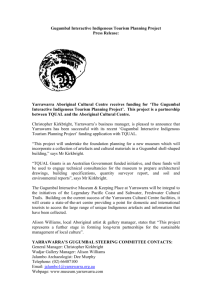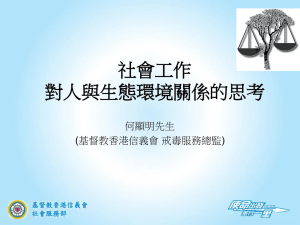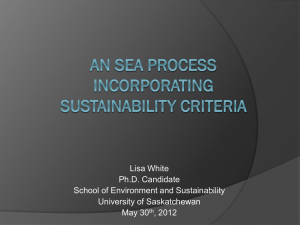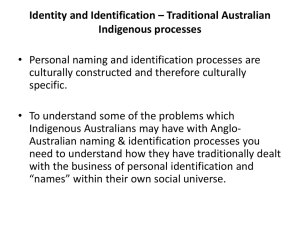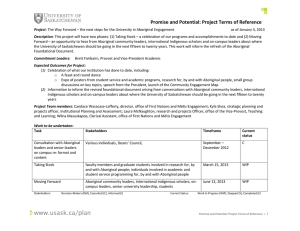U of S Vision Consultation: Roundtable Questions April 23, 2016...
advertisement
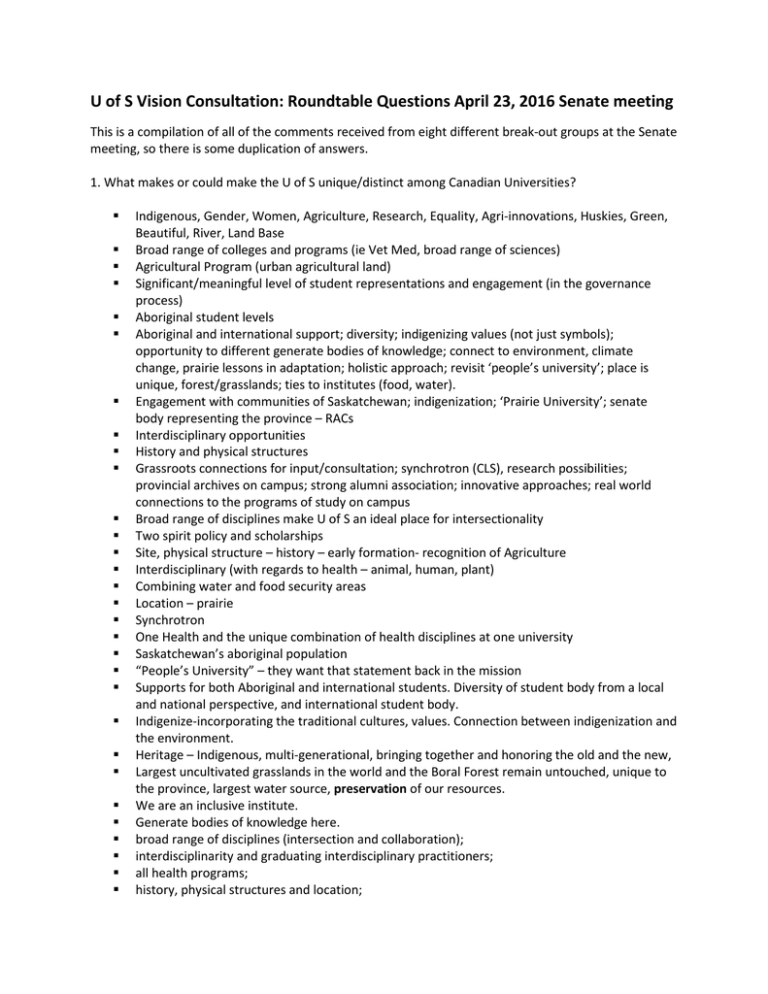
U of S Vision Consultation: Roundtable Questions April 23, 2016 Senate meeting This is a compilation of all of the comments received from eight different break-out groups at the Senate meeting, so there is some duplication of answers. 1. What makes or could make the U of S unique/distinct among Canadian Universities? Indigenous, Gender, Women, Agriculture, Research, Equality, Agri-innovations, Huskies, Green, Beautiful, River, Land Base Broad range of colleges and programs (ie Vet Med, broad range of sciences) Agricultural Program (urban agricultural land) Significant/meaningful level of student representations and engagement (in the governance process) Aboriginal student levels Aboriginal and international support; diversity; indigenizing values (not just symbols); opportunity to different generate bodies of knowledge; connect to environment, climate change, prairie lessons in adaptation; holistic approach; revisit ‘people’s university’; place is unique, forest/grasslands; ties to institutes (food, water). Engagement with communities of Saskatchewan; indigenization; ‘Prairie University’; senate body representing the province – RACs Interdisciplinary opportunities History and physical structures Grassroots connections for input/consultation; synchrotron (CLS), research possibilities; provincial archives on campus; strong alumni association; innovative approaches; real world connections to the programs of study on campus Broad range of disciplines make U of S an ideal place for intersectionality Two spirit policy and scholarships Site, physical structure – history – early formation- recognition of Agriculture Interdisciplinary (with regards to health – animal, human, plant) Combining water and food security areas Location – prairie Synchrotron One Health and the unique combination of health disciplines at one university Saskatchewan’s aboriginal population “People’s University” – they want that statement back in the mission Supports for both Aboriginal and international students. Diversity of student body from a local and national perspective, and international student body. Indigenize-incorporating the traditional cultures, values. Connection between indigenization and the environment. Heritage – Indigenous, multi-generational, bringing together and honoring the old and the new, Largest uncultivated grasslands in the world and the Boral Forest remain untouched, unique to the province, largest water source, preservation of our resources. We are an inclusive institute. Generate bodies of knowledge here. broad range of disciplines (intersection and collaboration); interdisciplinarity and graduating interdisciplinary practitioners; all health programs; history, physical structures and location; consultation and integration with community (grassroots); research work and relationships; CLS and the associated research; provincial archives and ability for historical research; college presence in the profession with participation in professional bodies (real world connection); distance learning; relationship with regional colleges Inclusive; outward preparation for other programs; isolation; communities we serve are across geographic distance; diversity in areas of study reflects the entire community; demands on faculty; science and arts; values arts as part of an education; integration; nurturing diversity; Saskatchewan based (importance to this provinces, big part of this community); beauty of campus; genuine Indigenization Community engagement is part of U of S distinctiveness; size of province and closeness of university to community activities (research, education, service); Students at the University are integrated into all governance bodies and the observation (from an X-student leader) was that the U of S is the envy of our student bodies across Canada due to true “voice” in university The Governance of the U of S was considered distinct (3 governing bodies) I believe that all the residents of this province, particularly generations of settlers to the province and Aboriginal people, have a unique connection to the land. Regardless of when people arrived, they have lived off the land and respected the land. Our university specifically the College of Agriculture and the research institutes on campus, Vet Med and Education, can highlight this reality through interdisciplinary study, research, prep on K-12 programs, and international connections: food security, water, agriculture, cultural factors 2. (Vision) Looking forward 10 years, what are your aspirations for the U of S? Seniors and youth working together; youth teaching seniors more technology; supporting each other; involving community. Sustainable funding/government relations/public Exploring new integral sources of revenue Addressing environmental issues ie. R & D in renewable energies Community engagement ie. students Innovation should continue Architecture, occupational and speech therapy Programs must meet needs of province Unique, centres for excellence for Canada All programs Indigenous knowledge Environment conservation contribution Strong Arts College vital to enhance working across disciplines CLS unique research opportunities Community collaborations (Kenderdine) Valuing on creativity more in programs Real world applications for research for communities Sustainability; ecological focus; needs to go beyond economic sustainability; what is the sustainability of indigenization, ecology and innovation Sustainability capture in curriculum and policy; university needs to determine what is sustainability; neutral on industry or it should be serving people, not industry We have to start to get serious about how the land defines us; knowledge from the university is reversed; we need to take responsibility for this Targets or expected outcomes should be more clear; professors need more background on teaching and learning University should be world model for outreach and engagement University is recognized nationally as a place where the university is improving life around the world We need to have agreement about how our goals are going to be achieved Their needs to be progressive motion in terms of society and university’s contributions to it (progressive means positive) This should be a home and safe place for discussion for students and community members People should be excited to be here We need a steady stream of funding; more predictability Role of our governing bodies Senate made up of representatives of “ordinary people” and professional organizations Focus on accessibility to programs for all students; consider expanded timelines to allow employment in between; preparation/linkages to D-12 to ensure smooth transitions; safe, welcoming campus; more community-based research Making the university inviting to all students, especially aboriginal students, newcomers, Canadians/Sask students Ensure a balance between introspection (SK issues) and global/diverse issues Maintain excellence and pursue higher academic goals Embrace new technologies even more Active recruitment of LGBT students and faculty Encouraging research on transgender and gender diverse individuals An LGBT president of the U of S The participation of the U of S president in Saskatoon Pride Festival Increase in Community based research, intersectional approaches. Removing barriers to graduate degrees for qualified students from alternative disciplines (e.g. Anthropology students pursuing graduate nursing degrees) More accessible, diverse More connections with real world (co-op programs) We need a call to action proving how great we are/can be. This includes a commitment to international aspirations. We need to pursue the opportunity afforded by the TRC report to advance a meaningful Aboriginal agenda at the U of S. We need to pursue outreach with respect to big research initiatives. Continue to diversify programs, continue to grow programs that are relevant (synchrotron) . Continue to grow what we have. Interdisciplinary crossover and enhancement to research and collaboration Collaboration with community, determining needs of the community, Value creativity in learning and support it. Create freedom of thought for students to be nurtured/provide opportunities, spirit of creativity. Real world relevance, developing knowledge and research. Strong college of the arts, University to be adaptable, Indigenous knowledge in all programs, environmental programming with an Indigenous content, Contribution to preservation and conservation, governance and Senate’s connection to the community; becoming the best small medical school in Canada; accessibility in all ways; financially sustainable; experiential learning/co-ops; links with the primary education system; better connection to career opportunities; students as priority; LGBT engagement/research; inviting to all students (especially Aboriginal and new Canadians); representative of our diverse population; growth in grad student numbers; intentionally embrace technology; the land we are on and the research that can be connected to global change bigger/smaller; wide range of programs; supportive while studying; enlightenment; critical thinking; creative thinking in how people think together; greater than just $; engagement; engagement with SaskPoly (accessibility in SK); Indigenization; research and culture (dynamic and interconnectedness) Financial sustainability – long term needed; Discussion about the need to keep majority of funding from public sources vs private and also noting the University lands as a significant resource. Within this recognition that we need to foster good relationships with government (key partner if we are to maintain our position as a public institution) The U of S should have as a goal support/sustainability around environment (range of issues including strength in ecology – provincially/regionally) -continued academic excellent Preparation of students to pursue professionals through a 21st century lens [we don’t always use 21st century thinking , particularly with technology] Equitable approaches to diverse learners so that the university is clearly respectful of cultural and linguistic diversity. Please don’t lose sight of local students while working on indigenization. Don’t lost sight of international students, newcomers and the “global lens” they bring into the U of S. 3. (Values) What values should guide the attitudes and behaviours of the university and its people? • • • • • • • • • • Indigenous; rural roots; equality; including diversity. Inclusion; diversity of opinion/perspective; incubator of thought; respect Not corporatizing; passion; integrity; respect; ethical; adaptability; respect for process; cultures coming together; diversity Teaching students how to learn; diversity; good listeners in engagement; “pure” of an academic environment free from outside influences – academic freedom, integrity; service; how are we organizing the university to up hold these ethics? Service to the public, to research, to the profession(s) Transitioning research to actual needs or issues in communities Communicating ethics Continuing to value diversity and difference We value the land that we are on – this is a commonality between indigenous and nonindigenous residents – the college of agriculture can become a world leader in research and sustainability Distance education opportunities – accessibility regardless of location; Explore enhancement or improvement Integrity and honesty and transparency; communicate our ethical stand on issues Freedom; safety; prevention (be proactive); “upstream thinking” Diversity and inclusion as a value Mutual respect Commitment to a living wage and benefits for employees and sessionals Removing obstacles and barriers to accessing education Responsibility to the people of Saskatchewan – translating research Recognition and celebration of difference Ethical Integrity; sustainable; oversight; inclusion Ethics and morals are the key to relationships Integrity of the university is key Transparency is critical [though how this gets worked out with respect to partnerships with the private sector is contentious] we need to be progressive we need to be an inclusive place – 4 different people spoke to this we need to be a respectful community sustainability [related to environmental values] service to the public (e.g. health professions); translation/communication; ambition; ethics; diversity; inclusion; celebration and acceptance of difference; freedom; • • • • • • • • • • • • • • • • • • • • safety; prevention/proactive/thinking up-stream; financial sustainability; taking the university to the people; integrity; honesty; transparency inclusive; open/listen; respect; services; critical thought; academic freedom; unselfish; part of the bigger community; engaging; inclusive; welcoming; citizenship inclusion, Support/respect diversity of opinion – the university is a place for “incubation of thought”; internationalization (this also noted as ensuring graduate students (who make up majority of international students) are represented respect for both non-indigenous and indigenous learners. Promote opportunities for all equitably more emphasis on behaviors that focus on professional ethics and goals; prepare students for real-world environments through more connections to business, professional environment, industry 4. Are there any other thoughts/comments for the committee? Educate general public of the benefits – safeguards; education – uranium – GMO (not all bad); license to farm – good; social media has scared people too much about GMO and uranium. It is important to move beyond “discrimination policies” towards creating positive and welcoming spaces of LGBT students and research. All employees – particularly faculty and administration – should have diversity training on gender and sexual diversity. Diversity includes LGBT PR campaign so done in the right way Mission – inclusion of the importance of arts/culture Noted an issue to address is GAA students not formally recognized by the governing bodies (only USSU) and this somewhat at odds with the University focus on internationalization as many of the grad students are international students” – a challenge to the USSU and GSSA to review bylaws (this was linked to our vision of internationalization and values /fair/equitable ) Through the vision, link future goals to the legacy of the university in Sask. We need to remind ourselves and our citizens that we have a century-old history. This is important for collective pride.

